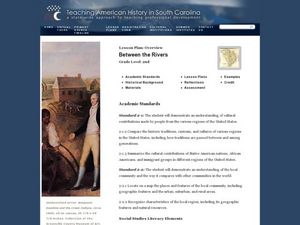Curated OER
Romans of the New World
Who were the Iroquois, and how did they compare with the Romans? Attached is a three-page article and a set of accompanying questions. Only four questions are included, but you could require your readers to write two or three...
National Endowment for the Humanities
Kennewick Man: Science and Sacred Rights
"Have respect for the dead!" Scholars investigate how science and religion often clash. As they look into the laws of science and the laws of religion, the legal ramifications at the federal level of both play into an argument they...
Annenberg Foundation
Native Voices
The Navajo people build their dwellings with the doors facing the rising sun in the east to welcome wealth and fortune. Pupils learn about the traditions of the Navajo people in the first part of a 16-part unit. They explore American...
DocsTeach
Lewis and Clark's Expedition to the Complex West
Lewis and Clark's famous expedition is a prime example of the United States' westward expansion. Aspiring historians examine maps from Lewis and Clark's journey, as well as discuss their interactions with Native American tribes. The...
Pace University
The Iroquois
During the early 1500s, parts of modern-day New York were inhabited by Eastern Woodland Native Americans. To learn about the daily life, value, and traditions of these tribes, fourth graders research the Iroquois. Groups select projects...
K20 LEARN
Allotment in Indian Territory: Land Openings in Indian Territory
To understand how the allotment policy embedded in the Dawes Act, passed by the U.S. government in 1887, affected the tribal sovereignty of Native Americans, young historians examine various maps and documents and Supreme Court cases...
Smithsonian Institution
Western Indian Wars
Why do many Native Americans live on reservations? An interactive resource teaches about how reservations came to be and the tragic history behind Native Americans moving from their lands. Teenagers read passages, view images, and click...
National Endowment for the Humanities
Hopi Poetry
The Hopi refer to corn as their children, demonstrating its importance to the Native American group. Class members consider the role of literal and figurative language by examining poetry from this indigenous group. The resource includes...
Curated OER
Indigenous Peoples’ Day
A activity looks closely at the history and importance of Indigenous Peoples' Day. Scholars view an engaging video, then create a book that celebrates Native Americans. Thoughtful discussion and research highlight their contributions.
K20 LEARN
Show and Tell Museum - Investigating Primary Sources: Read and Interpret Primary Sources
Scholars become detectives in a instructional activity that focuses on primary sources. Learners practice their observational skills by examining the teacher's artifact and visiting the Show and Tell Museum that highlihgts items from...
Curated OER
Changemakers Lesson Plans
An astronaut, a fashion designer, a Secretary of the Interior, an actor, and an Olympic Gold Medal winner! Teens and tweens have an opportunity to be changemakers as they research modern Native Americans and their many accomplishments...
Center for History Education
Pontiac's War
Invaders are coming: fight them off or run? Native American peoples had to decide this question after British colonists went west following the French and Indian War. Using a speech from Chief Pontiac, young historians consider if they...
Memorial Hall Museum
Problems and Events Leading Up To the Attack of 1704
Groups read primary and secondary sources detailing the ambush at Bloody Brook on September 18, 1675 and the attack on The Falls in May of 1676. After examining the results of each attack, groups reflect on the language used in the...
Curated OER
3rd grade social studies
In this social studies worksheet, 3rd graders complete multiple choice questions about Native Americans, sequencing history, geography, and more. Students complete 20 questions.
Curated OER
American Indians
Students research early Indian adaptations in this lesson. They research the different American Indian tribes. They also research and compare the tribes' rituals, daily lives, and their impact on the Europeans who came later to the...
Curated OER
American Indian Art
Students complete a unit of study about Native American visual art. In this visual art lesson, students complete five lessons to study Native American art.
Curated OER
Pooling Common Knowledge
Fifth graders examine Native American cultures. In this diversity lesson, 5th graders prepare oral reports based on the research they conduct regarding Native American clothing, holidays, and sports.
Curated OER
More Than Tipis and Feathers
Fourth graders research Native American People of the plains, the forest, the northwest coast and the desert. They compare how their lives were similar and how they were different. They make a model of one type of dwelling.
Curated OER
Between the Rivers
Second graders compare and contrast historical American cultures. In this American history lesson, 2nd graders participate in reading, writing, oral, and hands on activities. Students discuss the similarities and differences between...
Center for History Education
Should the Colonists Have Revolted Against Great Britain?
Should the Americans have taken the plunge and revolted against Great Britain? Using documents, including the famed Common Sense and a Loyalist response, pupils conduct a lengthy investigation of the question. The interesting resource...
Curated OER
What Should a House Do?
Students complete a unit of lessons on the similarities and differences between Native American homes and European settlement houses. They explore websites, read stories, design a dream house, and construct wigwam models.
Curated OER
Storytelling of the Four Tribes of Nevada
Learners work in groups to identify the major characters and events found in a Nevada Native American folklore story. Each of the groups takes on the role of a different tribe, and they are given a story from that tribe's oral history....
DocsTeach
Patent Analysis: Joseph Glidden's Barbed Wire
Barbed wire may have made cattle farming easier, but it brought to an end the free-roaming days of the plains. No longer could Native American groups continue their nomadic lifestyle, and the days of cowboys herding large groups of...
Curated OER
Mosaic America: Paths To The Present
Seventh graders study the ideologies of life, values, love, peace and struggle of African Americans, Latinos and Native Americans as citizens of the United States. Authors and artists are used as tools to open the eyes of the students...
Other popular searches
- Native American History 1920
- Wi Native American History
- Native American History Nj
- Native American History Vt
- History of Native Americans
- Native American History Map
- Native American History Month
- History Native Americans
- Us History Native Americans

























